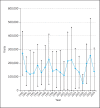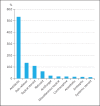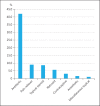Hidradenitis Suppurativa Management in the United States: An Analysis of the National Ambulatory Medical Care Survey and MarketScan Medicaid Databases
- PMID: 27172455
- PMCID: PMC4857854
- DOI: 10.1159/000431037
Hidradenitis Suppurativa Management in the United States: An Analysis of the National Ambulatory Medical Care Survey and MarketScan Medicaid Databases
Abstract
Purpose: To present nationally representative data demonstrating how frequently hidradenitis suppurativa (HS) occurs in specific groups and how it is currently managed.
Methods: We analyzed data from the 1990-2009 National Ambulatory Medical Care Survey (NAMCS) and the 2003-2007 MarketScan Medicaid databases for patients with a diagnosis of HS (ICD-9-CM code 705.83). Visits per 100,000 population of each race and ethnicity were calculated using the 2000 US Census data for specific demographics.
Results: There were 164,000 patient visits (95% CI: 128,000-200,000) annually with a diagnosis of HS in the NAMCS, and 17,270 HS patients were found in the MarketScan Medicaid over the 5-year period. Antibiotics were the most common treatment, followed by pain medications, topical steroids, and isotretinoin. Prescriptions of biologics and systemic methotrexate, cyclosporine, and acitretin were not observed in the NAMCS. Physicians prescribed medications in 74% of visits and used procedures in 11% of visits. African Americans, females, and young adults had higher numbers of visits for HS.
Conclusions: Our data showing a maximum of 0.06% of the population being treated for HS in a given year are consistent with the low estimates of HS prevalence. Compared to the current prescribing patterns, the more frequent prescription of biologics and systemic treatments may yield better outcomes.
Keywords: Antibiotics; Apocrine glands; Biologics; Demographics; National Ambulatory Medical Care Survey; Tumor necrosis factor inhibitors.
Figures









References
-
- Jemec GB. Clinical practice. Hidradenitis suppurativa. N Engl J Med. 2012;366:158–164. - PubMed
-
- Grant A, Gonzalez T, Montgomery MO, Cardenas V, Kerdel FA. Infliximab therapy for patients with moderate to severe hidradenitis suppurativa: a randomized, doubleblind, placebo-controlled crossover trial. J Am Acad Dermatol. 2010;62:205–217. - PubMed
-
- Miller I, Lynggaard CD, Lophaven S, Zachariae C, Dufour DN, Jemec GB. A double-blind placebo-controlled randomized trial of adalimumab in the treatment of hidradenitis suppurativa. Br J Dermatol. 2011;165:391–398. - PubMed
-
- Adams DR, Yankura JA, Fogelberg AC, Anderson BE. Treatment of hidradenitis suppurativa with etanercept injection. Arch Dermatol. 2010;146:501–504. - PubMed
-
- Davis SA, Narahari S, Feldman SR, Huang W, Pichardo-Geisinger RO, McMichael AJ. Top dermatologic conditions in patients of color: an analysis of nationally representative data. J Drugs Dermatol. 2012;11:466–473. - PubMed
LinkOut - more resources
Full Text Sources
Other Literature Sources

